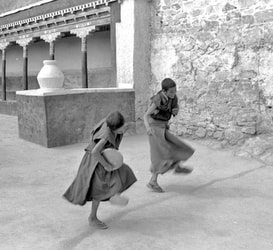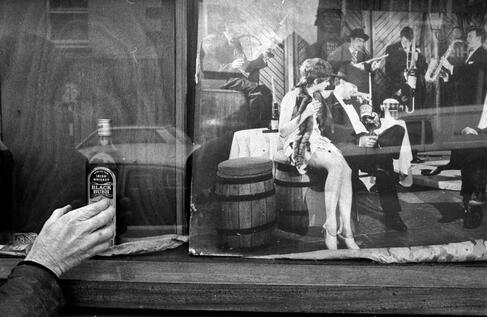Scott Younger CV
Scott is a Kiwi. He has lived all over the World. He has a Business Degree and worked in the IT Industry. He taught himself Photography and the Black and White Darkroom. He has an archive of 1.3 million photos and film. Some of it is displayed here ... most has not even been reviewed yet for he gets waylaid with more opportunities and thus material.
He loves the Black and White Print. Not all of his favoured photos are displayed here as he favours the Print.
(He is also reluctant to put perfect, high res images up on the Web ... too many thieves about.)
He wonders and wanders ... the World being his oyster ... the camera a tool in his hand to use as a means of communication with the environment, humankind, flora and fauna and iniquity ... to trap his vision and to live life without bounds. His enquiring mind has no limits ... many adventures have been had including being arrested in 7 Countries ... and assisting many projects / ideals.
He loves the Black and White Print. Not all of his favoured photos are displayed here as he favours the Print.
(He is also reluctant to put perfect, high res images up on the Web ... too many thieves about.)
He wonders and wanders ... the World being his oyster ... the camera a tool in his hand to use as a means of communication with the environment, humankind, flora and fauna and iniquity ... to trap his vision and to live life without bounds. His enquiring mind has no limits ... many adventures have been had including being arrested in 7 Countries ... and assisting many projects / ideals.
|
Scott works with his camera for love, not money. The only client is himself. He works very hard at it because he perceives the world as a complex and multi-faceted place of shifting sands. He clings to continuities in order to resolve idiosyncrasies. Which is why, in his words, he ‘Wonders and Wanders’ - a fine title. But not quite as comfortable as it reads. All the good photographers I have known have done the same thing. It is an impulse which drives; a sense of curiosity and a taste for adventure which is way beyond a bungy jump into temporary oblivion. This could be described as ‘looking and learning’. Scott has done just that but the journey has not been a simple one for he has had to confront himself. In truth, photography is a clever and subtle as a way of speaking your mind. One has to be emphatic and truth telling while tickling the viewer, charming and persuading them to your point of view. ‘Oh’ you might say , ‘if I’d been there I could have done that’. But you were not ‘there’, Scott was - doing reality checks every time he raised the camera. In that you get an elegant simplicity. He knows what to point at and when to press. Indeed, what you get is not the memoirs of a globe-trotter with itchy feet but a portfolio of self portraits. In that he is in accord with some of photography’s most accomplished practitioners who use this medium to record an outward reality while exploring an inner truth. It should look effortless while containing the photographer’s essence. No easy task. He combines lyricism with realism and is informed by visual literacy with a willingness to examine and question. Scott’s pictures are all about questions, not simple answers. I’m glad he took them. Peter Turner - Editor Creative Camera 1970s/1980s. |
|
'Whisky Bottle'
What is it that makes the difference between the successful and unsuccessful photograph? For Scott Younger it is all to do with synchronicity. That the important links, from meeting the right people at the right time of our lives, to being in the right place for things to happen, to making decisions at the right moment are due not to serendipity–that happy knack of making unexpected discoveries by accident, but to synchronicity, which, in the artist’s words has more to do with “being on one’s pulse, doing what one ought to be doing.” It’s a condition he accepts and revels in, and not a matter of fate. While some of his images would have come so easily that they seemed to make themselves, inevitably, others will have been made the hard way, by the peculiar process of trial and error that accompanies this kind of creative endeavour. Which were the more difficult, however, won’t be obvious, because the point of a successful photograph is to appear effortless and inevitable. |
Let us refer to the special picture Scott Younger made in an unidentified Irish street. Long before I saw the proof sheet that revealed different aspects of Whiskey Bottle, 1986, my first impression from the roughly 20 x 25 cm finished print was a double take. I had to look twice to figure out what I was looking at.
This consciously repeated scrutiny instantly recalled that state of intoxication when there is a compulsive desire to touch something tangible, to come back to earth. I couldn’t help shaking my head, and laughing at this uncanny visual pun, all the while conscious of a contradictory sombre aspect to it. Younger has captured a kind of surreal alcoholic mirage of another fantasy, the half-truth of the good life that goes with alcohol. The bromide band was playing, the bromide girl inviting, the bromide man lovingly cradling their bromide bottle baby, but the real bottle, the full bottle, and the whole point of the promotion, was out of reach behind glass. I calculated that the nominal subject matter of this photograph was a glass cabinet with bottles, and an advertising photograph, sitting on a shelf inside a pub. I pictured an inventive patron lending a droll hand and the photographer’s fast reflex. I carried this initial fiction of a fiction around until I saw the proof sheet that disproved it. Scott confided that he had persuaded a passerby to raise his hand to the shop window. This discovery that he was capable of directing a stranger to raise his hand just so—he made only the one exposure—suggests a supremely confident picture maker, because, to achieve such a consciously structured image would lead most serious photographers to make half a dozen or more variations as insurance. Younger acknowledges that his photographs are “single pictures relating to different moments in time of my wider perception,” and that in recording his journey through time, “any group of my photos still only catches a bit of my perception.” John Turner Professor of Photography (Retired), Auckland University |

